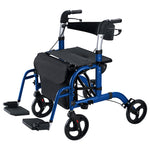Your cart is empty
Looks like you haven't added anything to your cart yet
Once Upon a Time a Health Savings Account was Created
Have you ever wondered where HSAs came from? Who created them and why? Well this is the post for you, Friend! Come with me on a journey as we explore the origin story of Health Savings Accounts...

Every superhero has their origin story; Where they got their powers, why they choose to fight. Well, Health Savings Accounts are no different. They are here to help you be the hero of your financial journey and today I wanted to share with you exactly where it all started.
THE DEBUT
What we know as an HSA first made its entrance in 2003, but its roots go back to the 1980s. The landscape of healthcare was changing, turning to a more consumer-driven model, and costs for both healthcare and deductibles were increasing. It was during that time that it became especially important for those with a high deductible to have a good way to save for medical expenses.
That’s why Congress began discussing medical savings accounts, or MSAs. Their goal was to have an option for people to be able to set aside tax-free money specifically for medical expenses and spend it tax-free as well. (Does that sound familiar to you? Learn about the “triple tax advantage” of an HSA here!)
MSAs became official in 1996 with the Health Insurance Portability and Accountability Act (HIPAA), starting what became known as the “Archer MSA Experiment.” It was named after Representative Daniel Archer, who was one of the main sponsors of its creation. Over the next 5 years, MSAs were tested on a limited group of people, and several issues quickly became apparent.
HIPAA laws severely limited the availability and growth, keeping MSAs from being the ideal savings vehicle. For example, only self-employed individuals and employees of small businesses (less than 50 employees) were eligible to open an MSA. In addition, unspent funds did not rollover from year to year, so there was no accumulation on the account. If these MSAs were going to do the heavy savings lifting like the original idea envisioned, then something needed to change.
During his time in office, President George W. Bush wanted MSAs to become more than just the experiment they currently were, and he wanted to lift the HIPAA restrictions so they could be available to all. He saw the potential with such an account and wanted to get the budding idea flourishing.
So, Under President Bush’s direction, the Whitehouse began to push for a health savings account that would be widely available, pay for any medical-related expense, and could serve as a savings vehicle to last into retirement. (Learn more about how your HSA could help you save for retirement here!), but congress had some concerns about what this idealistic account would do to the U.S. Budget. They were already discussing the Medicare Prescription Drug, Improvement, and Modernization Act (MMA), and it was expected to cost the U.S. $400 billion over the next ten years. (Later it was revised to 1.2 trillion, so don’t lose your wing feathers.)
With such a conflict, what were they to do?
THE UPGRADE
In the meantime, another important milestone for the HSA we know today took place. On June 26, 2002, The IRS issued a clarification on the parameters of HRAs, or health reimbursement arrangements. An HRA is a health benefit set up by the employer, and they decide how much to contribute to the plan. As an employee you can get reimbursed for medical expenses using that amount.
Among other things, the IRS stated that unused amounts of an HRA could be carried over to later years. This is very significant because this became a key feature of HSAs when they were created and it is still one of its strongest features.
THE EMERGENCE
After sufficient time and debate, it finally came time for the official birth of our modern HSAs. Congress approved an amendment to the MMA that would include the creation of HSAs once a few balances were attached:
» The account holder must be enrolled in an HSA qualified HDHP (high deductible health plan)
» Generally, HSAs could not be used to pay for insurance premiums
» Contributions were to have a yearly cap
And so, Dec 8, 2003, the MMA was officially signed into law and HSAs became available on Jan 1st, 2004. It took the best of both MSAs and HRAs and delivered a powerful way for consumers to take control of their finances and be their own hero.
HSAs are an incredible way to keep healthcare costs down because a high deductible means a lower premium and the completely tax-free funds can be used to pay for deductible amounts. What could be better than that?
HSAs have taken a long journey to become what they are today, but aren’t you so glad they’re here?
Curious about the differences between Archer MSAs and HSAs?
Here is a quick comparison:
» Only self-employed individuals or employees of small businesses with a high deductible health plan could open an MSA, unlike an HSA which allows any individual not on Medicare who has a qualifying HDHP
» Archer MSAs had higher minimum deductibles than current HSAs
» Both employer and employee could not contribute to an Archer MSA in the same year, which is exactly opposite of what an HSA today allows. Within the maximum contribution limit allowed, any party can contribute as much as they desire.
» Archer MSAs had a smaller contribution limit than HSAs
» There was no catch-up rule for Archer MSAs. HSAs allow you to contribute an additional $1,000 per year the year you turn 55.
See why something needed to change if consumers were going to be able to have the ideal savings vehicle?
Thanks so much for reading, friend! Feel free to check out my other posts and give me a hoot down below on what topic you want to see covered next!
Sincerely,
Hoolio
- Choosing a selection results in a full page refresh.










